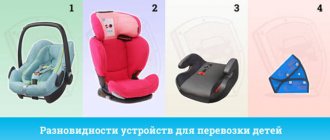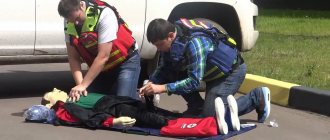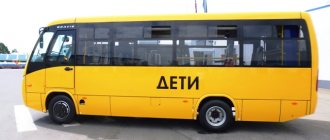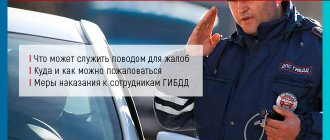According to statistics, 82% of children injured in road accidents were transported without using a child restraint. A seat belt won't help much.
The point is the design feature of the vehicle. The car seat belt is designed for an adult. When securing a child with a belt, the strap passes next to the neck. Consequently, in the event of the slightest traffic accident, the strap will simply strangle the baby.
It is also prohibited to place a child on the lap of a rear passenger. Experiments show that even in a collision at a speed of about 50 kilometers per hour, the passenger will simply crush the child into the front seat. Imagine what it would be like at higher speeds.
Photo from the site odnadama.ru
So, how can you keep your child safe? Restraints for children in cars have been on the market for a long time. And since 2007, legislation has required their presence when transporting children under 12 years of age. Violation of the rule entails a fine of one salary.
Statistics
A study was conducted in the United States of America in 2003. We examined a database of road accidents involving children from 4 to 7 years old. The review included more than 3,500 accidents involving more than 4,000 children.
The study found that children who were restrained in car seats had 59% fewer injuries. They were not diagnosed with injuries to the abdomen, neck, back or spine. Children fastened with a regular seat belt, unfortunately, cannot boast of such rosy statistics.
Other North American studies have also shown that vehicle restraints reduce the risk of death in a traffic accident by 28%.
And a 2004 Australian study found that children in car seats were 82% less likely to be injured than those restrained in a regular seat belt.
How do children perceive
This is interesting
According to many forums, babies respond positively to restraints.
On a forum for young mothers, users write that it is even easier to place children in a car seat than in the back row of a vehicle. Although, during the period of vigorous activity of the child, that is, from one to two years, on long trips the baby will have to be entertained with something.
Toys and books will come to the rescue, and if there is a multimedia system in the car, children can be entertained with cartoons and other entertainment programs. Young mothers also complain about tinting. Children do not approve of it due to poor visibility. So if you have a darkening film, you will have to remove it for a while.
What is a "Child Restraint"
The concept of a child restraint system is given in GOST R 41.44-2005 ().
According to this standard, a child restraint system is a set of elements consisting of:
- straps or flexible elements with buckles;
- control devices;
- fastening parts;
- and in some cases, an additional device (for example, a bassinet, a removable child seat, a booster seat, and/or an impact shield) that is attached to the interior of the vehicle body.
The device must be designed so that in the event of a collision or sudden braking of the vehicle, it reduces the risk of injury to the child and limits his mobility.
Child restraints are divided into five weight groups:
group 0 (group 0) - for children weighing less than 10 kg; group 0+ (group 0+) - for children weighing less than 13 kg; group I (group I) - for children weighing 9-18 kg; group II (group II) - for children weighing 15-25 kg; group III (group III) - for children weighing 22-36 kg.
Disadvantages and Limitations
Despite the good characteristics of the ISOFIX system, it also has its negative sides:
- The main difference between such car seats is that they are overweight; they are about a third heavier than a regular child seat. This must be taken into account if you are going, for example, to the country, and the car will be full.
- All car seats equipped with the ISOFIX safety system are very expensive, their price exceeds 50% of the cost of an ordinary child seat. And not every parent can afford this luxury.
- And limiting the child’s weight is also important. The restraint system can be useful and fully ensures reliability only if the child weighs no more than 18 kg, since in a collision the main load falls on the fasteners, and it may not withstand a larger passenger weight.
- You can also highlight the lack of versatility of seats with such equipment installed - adjusting the position of the car seat in the back seat to suit the child’s needs (for example, extending it to give it a lying position) can sometimes be very difficult.
These car seats are best suited for younger children, so it is advisable to use them if your child is between 0 and 5 years old.
What devices can be used
The device can be used if:
- it corresponds to the weight and height of the child;
- its design complies with GOST R 41.44-2005.
Child restraints can be of two types: one-piece and non-one-piece.
One-piece retention devices. They are a set of all the elements necessary to secure the child in the device. Examples: bassinets, car seats.
Non-integral restraint devices. Includes a partial restraint that is used in conjunction with an adult seat belt to form a complete child restraint. Examples: boosters and seat belt adapters.
How to secure a car seat with ISOFIX in the car
Since there are many different models of ISOFIX car seats on the market, when installing, be sure to follow the instructions that came directly with the seat you purchased.
Of course, for the first time it will take some time, but once you understand the essence of the design, subsequent installation will not require much effort.
Contact a consultant at a car seat store for help, let him explain in detail to you the installation principle using the example of the selected model, or ask him to help you properly secure the device in the interior of your car.
The principle of attaching car seats with ISOFIX is approximately the same:
- Carefully inspect the joint between the seat and backrest, find the ISOFIX mounting brackets. Some varieties may be additionally equipped with metal guides for installing chair brackets, but this is not necessary.
- Remove the brackets from the chair and snap both components into place. Pay attention to the correct fixation indicators; they should switch from red to green.
- Now secure the seat with the standard seat belt of the car itself and adjust its tension. To do this, the child car seat is raised and the belt is thrown over the back, passed through the guides marked in red and fastened in the usual way.
- Now you can sit your baby down and adjust the five-point harness to his size.
Draw your attention to! All plugs must be removed and stored in the glove compartment; at the end of the trip, they are returned to their place so as not to damage the upholstery.
Watch a short video that will help you correctly and quickly install an anchor car seat in your car:
How to install the base:
- Place the base base on the seat, use the button to extend the fasteners, it is located in the front. Snap all the parts with brackets, if everything is done correctly, you will see that the indicators have changed color from red to green.
- Move the structure as close to the back as possible.
- Pull out the additional retractable floor rest, use the button to adjust the height, after which the green indicators should light up.
- Now install the baby car seat (cradle) on the base. You need to combine all the fasteners until you hear a click. Again, see if the green lights come on.
- Place your baby in a seat and adjust the seat belts.
- In order to remove the structure, there is a special lever on the back wall; pull it.
The presented video instructions clearly demonstrate the sequence of actions when installing a car seat with an ISOFIX base:
Get additional legal advice online by submitting your question at the end of the article.
Rules for installing restraint devices in cars
Statistically, the safest place is the middle seat of the back row. The most dangerous is the front passenger seat. Consider this information when arranging restraints in your vehicle.
Car seats can be installed both in the front passenger seat and in the rear.
If you install a seat in the front, be sure to take into account the design of your car. If it has a front passenger airbag, it must be disabled for rear-facing child seats.
Frameless car seats
You can also find on sale a so-called frameless car seat - a rag device without any rigid frame.
This device is attached to the back of the rear car seat using sewn-in straps and secures the sitting child both with its belts, like a standard child car seat, and thanks to a regular seat belt, which is threaded into the compartment provided by the design and fastened in the usual way.
Low price and compact placement in the car interior are the main advantages of this device.
The disadvantage of a frameless car seat completely covers all the advantages - the device does not ensure the safety of the child if the car gets into an accident.
Watch a short video about the crash test results of so-called other restraint devices:
When choosing a restraint system, you should understand that the use of devices that have not passed crash tests will not only not protect the child from injury in the event of an accident, but may themselves serve as a source of additional serious injuries. Remember, saving can cost a child’s life!
What rules for transporting children were in force before July 2017?
You can transport children in a car provided that their safety is ensured. In this case, the design features of the vehicle must be taken into account.
Children under 12 years of age can be transported in cars equipped with seat belts only using child restraints that correspond to the weight and height of the child, as well as other means that allow the child to be fastened with the seat belt provided in the car.
Transportation in the front seat of a passenger car is permitted only with the use of child restraints (clause 22.9 of the Russian Traffic Regulations).
Car seat
For example, a device such as a car seat is intended for the youngest passengers, up to a year old. But on sale you can also find universal models that can be used for slightly older children. The label will indicate category 0+ .
Children are transported in it lying down, but calling it a full-fledged child car seat is a stretch, although this device is approved for transporting babies.
Such holders are made either from durable plastic or metal, but always with a soft special covering. You can only fasten it in the direction opposite to the movement, otherwise the child may be seriously injured during sudden braking. There are other models of this type of device on the market, which are mounted on the rear seats perpendicular to the movement of the car.
Rules for transporting children in a car 2020-2021
On July 10, 2017, amendments to the Traffic Rules of the Russian Federation regarding the requirements for transporting children, approved by Decree of the Government of the Russian Federation dated June 28, 2017 No. 761 (), came into force.
According to these requirements:
Transportation of children under the age of 7 years in a car and a truck cab that is designed with seat belts or seat belts and an ISOFIX child restraint system must be carried out using child restraint systems (devices) that are appropriate for the weight and height of the child.
In other words, only in a car seat.
Children aged 7 to 11 years (inclusive) must be transported in a car and truck cab using a car seat or using seat belts, and in the front seat of a car - only in a car seat.
In addition, according to current rules, it is prohibited to leave a child under 7 years of age in a car while it is parked in the absence of an adult (clause 12.8 of the Russian Traffic Regulations).
Types of child restraint systems. Pros and cons of each category
Russian legislation adheres to the global standardization of determining the category of child restraint systems:
- Category 0 includes designs for babies up to 10 kg in weight, age group up to 1 year;
- category 0+ is designed for children under 1.5 years old weighing about 13 kg;
- to 1 – child weight up to 18 kg in the age category up to 4 years;
- ko 2 – with body weight up to 25 kg and age up to 7 years;
- 3 category of devices for children weighing up to 36 kg and age from 7 years.
This gradation of categories is primarily aimed at making it easier for parents to choose the right device for their child.
But there are so-called transformers that can be adjusted in one direction or another to suit the child’s shape and weight changing over time. This will be indicated on the product label, for example, category 0-0+ or 1-2-3 .
But not all manufacturers follow the same standardization of the names of child restraint systems, and many companies that produce child car seats assign their own names to them. They have taken root among the people, and car enthusiasts already understand for which category of children this or that device is intended.
Let's look at each category of child restraint system in more detail.
Is it possible to use a “booster” when transporting children?
Boosters can be used when transporting children if the device meets the requirements of GOST R 41.44-2005 (Russian standard PCT) and is selected in accordance with the weight and height of the child being transported. When preparing this material, a request was sent to the traffic police to clarify this issue. The answer is attached below:
Fine for a child seat (lack of one)
For transporting children in a car in violation of these rules, a fine is provided - Part 3 of Art. 12.23 Code of Administrative Offenses of the Russian Federation.
- a fine for the driver in the amount of 3,000 rubles;
- for officials - 25,000 rubles;
- for legal entities - 100,000 rubles.
according to article
Write to our lawyer and he will help you understand automobile legislation. We will consider controversial situations and tell you how to act according to the law.
Don't miss new useful publications
We will tell you about the intricacies of the legislation, help you understand it and tell you what to do in controversial situations.










